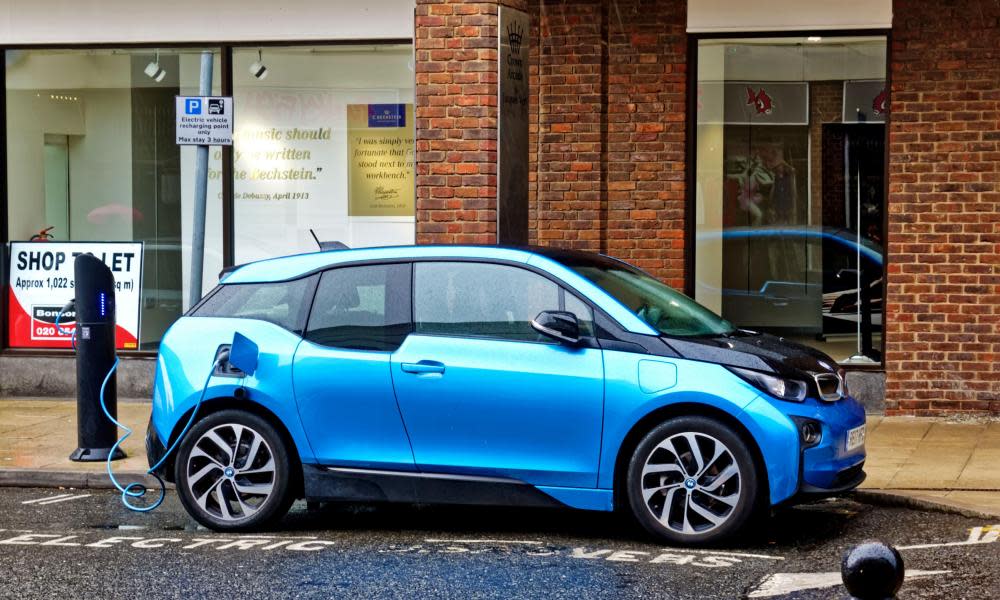Poor EV take-up to cost Australia’s health system $1tn by 2050, modelling shows

Australia may be left with almost a $1tn health bill by 2050 if it doesn’t boost the take-up of electric vehicles, according to a new report released on Sunday.
But this could be slashed in half by setting an ambitious target to convert every car in the country to electric by 2035.
The modelling was released by the Australian Conservation Foundation (ACF), which commissioned accounting firm Deloitte to examine the community benefit from increasing the uptake of electric vehicles (EVs).
Related: Not coming to a showroom near you: the new electric cars Australia will miss out on
A “bespoke economic model” was used to examine three scenarios: whereby Australia achieved net-zero road transport emissions in 2035, 2040 and 2050. These scenarios compared the cost of air, noise, water and greenhouse gas pollution caused by petrol- and diesel-powered cars, and those of EVs.
Petrol cars contribute heavily to air, noise and water pollution through the particles emitted from the exhaust and through the waste grease, oil and rubber needed to run them. By contrast, electric vehicles have fewer components and more efficient motors.
As this pollution leads to illness, the cost ends up being borne by the health system.
The report found that under the “business as usual” scenario – where nothing is done to support uptake – costs will mount to $864.9bn by 2050, with air pollution alone amounting to $488.2bn.
New South Wales and Victoria will bear the brunt as the most populous states, with costs mounting to $257.7bn and $203.6bn respectively. On a per-capita basis, the combined use of private transport and freight was greatest in Western Australia, where the cost was $43,900 per person.
However, in a scenario where EVs made up 26% of the private car fleet by 2030 and 100% by 2050, Australia would avoid $233bn in costs. A more ambitious scenario where a 28% share is achieved by 2030 and full uptake in 2045 would see $335bn in costs side-stepped.
A rapid transition of the entire private car fleet to EV by 2035, when coupled with better public transport systems, would see $492bn in costs avoided.
• Sign up to receive an email with the top stories from Guardian Australia every morning
Dr Eamon McGinn, a partner at Deloitte Access Economics, said while these figures were broadly understood among government departments, they are “not front of mind” for many people.
“We create invisible, unborne costs whenever we go driving. Obviously we pay for fuel and the maintenance, but there are these additional costs we impose on our neighbours and our community,” McGinn said.
“We think about petrol costs, we think about getting stuck in traffic. We don’t necessarily think about the noise, or the pollution coming out the tailpipe or the damage to waterways.”
Matt Rose, ACF’s economy and democracy program manager, said the report was unique in that it sought to measure the cost of inaction.
Related: NSW transport minister wants federal government to use electric vehicles in fleet
“Transport emissions are the second-largest source of emissions in Australia and they’re growing,” Rose said. “There is a cost to not moving and this shows what those costs are in our built-up city areas.”
The report assumed that all EVs would be powered entirely by renewable energy and obtained its data from the Bureau of Infrastructure and Transport Research Economics, and Australian Transport Assessment and Planning guidelines.
The honorary secretary of Doctors for the Environment, Dr Richard Yin, said independent research suggested the combined pollution from coal-fired power and internal combustion engines caused 5,000 deaths a year, with some studies finding the cost to the health system running as high as $24bn a year.
“It’s a ginormous hidden cost,” Yin said. “Worldwide for example, there were 8 millions deaths globally in 2018. That’s a year.”
While the goal should be for all electric vehicles to be entirely powered by renewable energy, Yin said there were still benefits even where the power was drawn from coal.
“There are advantages even if you are sourcing power from coal-fired power stations because the vehicles are more efficient,” he said. “The benefits are just multiplied when we transition to renewable energy and get rid of coal-fired power stations as well.”

 Yahoo News
Yahoo News 
